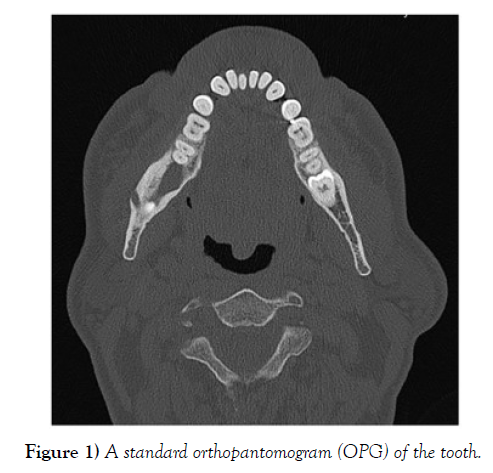Case Report on Third Molar Teeth with Standard Orthopantomogram
Received: 02-Jan-2023, Manuscript No. ijav-23-6076; Editor assigned: 05-Jan-2023, Pre QC No. ijav-23-6076 (PQ); Accepted Date: Jan 24, 2023; Reviewed: 19-Jan-2023 QC No. ijav-23-6076; Revised: 24-Jan-2023, Manuscript No. ijav-23-6076 (R); Published: 31-Jan-2023, DOI: 10.37532/1308-4038.16(1).238
Citation: Karl M. Case Report on Third Molar Teeth with Standard Orthopantomogram. Int J Anat Var. 2023;16(1):250-251.
This open-access article is distributed under the terms of the Creative Commons Attribution Non-Commercial License (CC BY-NC) (http://creativecommons.org/licenses/by-nc/4.0/), which permits reuse, distribution and reproduction of the article, provided that the original work is properly cited and the reuse is restricted to noncommercial purposes. For commercial reuse, contact reprints@pulsus.com
Abstract
This case report presents an impacted third molar with associated dentigerous tubercle in which the IAN is externalized and runs along the side face of the beak. This case reiterates the limitations of standard radiographic ways similar as the orthopantomogram.
Keywords
Dentigerous tubercle, Radiographic ways, Orthopantomogram; IAN
INTRODUCTION
Third molar surgery remains one of the commonest procedures carried out by oral surgeons. One of the main enterprises whilst performing this procedure is inferior alveolar whim-whams (IAN) damage [1]. We present a case of an unusual anatomical variation in which the inferior alveolar whimwhams was personified. This case reiterates the need for applicable preoperative radiological assessment to identify the anatomic relationship of IAN with third molar teeth. In this occasion, an altered approach was needed to save the IAN. This report is in line with the dread criteria.
CASE REPORT
Medically fit 50- time-old manly presented with a longstanding sinus in the right lower third molar region with intermittent pain, swelling and discharge. A standard orthopantomogram (OPG) showed the tooth to be horizontally impacted with an associated cystic lesion. Divagation and narrowing of the inferior alveolar conduit was also noted on the OPG, suggesting a close approximation to the IAN. A motorized tomography (CT) check-up was attained to further assess the relationship and course of the whim-whams. This showed the whim-whams could be seen covering indirectly and superiorly in the buccal cortical bone within a corticated channel (Figure 1). Piecemeal from the forenamed cystic lesion, no other adverse features were reported by the adviser radiologist.
DISCUSSION
There have been numerous mortal anatomical studies and, more lately, radiological studies that examine the course of the IAN [2]. In the maturity of cases, the IAN is set up inferior to the impacted third molar. Positional variation of the whim-whams in relation to the tooth tends to be in the buccolingual aeroplane.
Showed that 74 of IANs travel inferiorly and lingually to mandibular third molars [3] a superior and buccal placement of the IAN, as in this case, is extremely rare. We believe this is the first report of an externalized IAN with clinical and radiological correlation. No information is presently present in the literature regarding the prevalence of this variation. Some may argue that our finding is secondary to the tubercle rather than a true anatomical friction. Still, given that there was no bony expansion or change to the mandibular figure, we feel this friction is most likely to be anatomical, rather than pathological. The fact that there was complete cortical bone between tubercle and whim-whams further supports our thesis. We appreciate that odontogenic excrescencies can displace the IAN conduit. Still, despite18.1 of odontogenic excrescencies being dentigerous in nature, the instantiation of the IAN has not been reported a finding with these lesions. Therefore, in the balance of chances, we feel that instantiation of whim-whams seen is this case is indeed due to an anatomical variation rather than a result of pathology [4-5].
CONCLUSION
Prevalence of endless IAN damage ranges from0.35 to8.4. Although a rare complication, the counteraccusations of whim-whams damage can be significant for the case. Timely and accurate pre-operative visualization of whim-whams is consummate in a safe clinical practice and reduces the threat of gratuitous actions. Although the OPG has classically been used in the vaccination of whim-whams propinquity to lower third molars, it’s limited in that it does not permit three- dimensional assessment of the inferior alveolar conduit position. Cone ray CT has been proven to have better perceptivity and particularity in demonstrating whim-whams and tooth connections. It allows the surgeon to plan the surgical approach to minimize threat and deliver a safe service. The CT, in this case, handed vital information regarding the propinquity and instantiation of the whim-whams, leading to the revision of surgical fashion. Without this vital information, damage to the IAN could have been caused on reflecting the delirium. The authors advise the use of Cone ray CT to assess third molars which have adverse features on plain film radiographs.
ACKNOWLEDGEMENT
None.
CONFLICTS OF INTEREST
None.
REFERENCES
- Tantanapornkul W, Kiyoshi O, Yoshikuni F, Masashi Y. A comparative study of cone-beam computed tomography and conventional panoramic radiography in assessing the topographic relationship between the mandibular canal and impacted third molars. Oral Surg Oral Med Oral Pathol Oral Radiol Endod. 103(2):253-259.
- Jones AV. Craig GT. Franklin CD. Range and demographics of odontogenic cysts diagnosed in the UK over a 30 year period. J Oral Pathol Med. 35(8):500-700.
- Rood JP, Shehab N. The radiological prediction of inferior alveolar nerve injury during third molar surgery. Br J Oral Maxillofac Surg. 28(1):20-25.
- Sarikov R, Juodzbalys G. Inferior alveolar nerve injury after mandibular third molar extraction: a literature review. J Oral Maxillofac Res. 29; 5(4):e1.
- Maegawa H, Sano K, Kitagawa Y. Preoperative assessment of the relationship between the mandibular third molar and mandibular canal by axial computed tomography. Oral Surg Oral Med Oral Pathol Oral Radiol Endod. 96(5):639-46.
Indexed at, Google Scholar, Crossref
Indexed at, Google Scholar, Crossref
Indexed at, Google Scholar, Crossref
Indexed at, Google Scholar, Crossref







